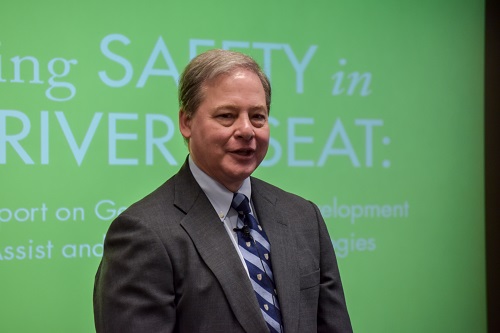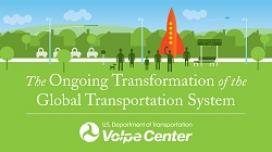Putting Safety in the Driver's Seat
From motorized buggies to muscle cars to four-door family sedans, three core concepts have predominated the past century of innovation in personal automobile travel:
- A car is owned by an individual.
- A car is driven by an individual.
- A car is propelled by internal combustion.
With self-driving cars, cars that talk to each other, and cars that communicate with infrastructure being close on the horizon, the paradigm for the next hundred years might look more like this:
- Zero crashes.
- Zero congestion.
- Zero emissions.
That's according to Harry Lightsey, executive director of Emerging Technologies Policy at General Motors North America, who spoke as part of Volpe's 2017 speaker series, The Ongoing Transformation of the Global Transportation System.
"We've seen a pretty dramatic increase in the number of crashes on our roads and highways, and in the number of fatalities," Lightsey said. "We can't ever forget that this is a tremendous cost that we as a society pay every day for our ability to get around. But we have the opportunity to change all that."
Watch video highlights of Harry Lightsey's talk at Volpe.
Technology and Society Converge with Self-Driving Vehicles
Technology is advancing, societal trends are changing, and new visions for self-driving vehicles are emerging.
New electric car motors, for example, are offering more mileage per full charge, and several manufacturers have recently announced plans to increase production of all-electric or hybrid electric-gasoline vehicles over the next half-decade.
Ridesharing too, in just a few years, has become acceptable and widespread. The challenge now, according to Lightsey, is not to build a vehicle for every consumer, but to build a vehicle that can work in a specific geographic area for multiple short trips.
"Our vision for self-driving vehicles for the foreseeable future is geo-fenced in a limited operating area," Lightsey said. "Fleets of vehicles that are not positioned as retail sale vehicles, but to provide mobility services like ridesharing. That way we can control the fleet when the vehicles are deployed and not deployed."

Harry Lightsey, executive director of Emerging Technologies Policy at General Motors North America, recently spoke at Volpe as part of The Ongoing Transformation of the Global Transportation System. (Volpe photo)
Meeting Safety Standards without a Human Driver
Beyond the shorter-term possibility of automated and fully electric ridesharing vehicles, policy makers and carmakers will need to work together to define the details for a new, longer-term vision for the personal automobile, Lightsey said.
New guidance from the National Highway Traffic Safety Administration (NHTSA) and previously released research from the Intelligent Transportation Systems Joint Program Office, NHTSA, and Volpe are helping to clarify that vision.
"It wasn't long after I last talked here that you released the seminal work on looking at where we were with safety standards in terms of how they could accommodate self-driving vehicles at high levels of automation," Lightsey said. "The Volpe report is kind of the bible for that now."
Legislation at the federal and state levels will be one big driver of what the future of self-driving vehicles will look like, Lightsey said.
Historically, legislation at the federal level has focused on vehicle performance and parameters. At the state level, legislation has focused on driver performance. With self-driving vehicles, that line becomes more blurry, Lightsey said—and many regulations explicitly or implicitly refer to a human driver.
"We think there has to be a bridge that gets us from where we are to when we do have rules," Lightsey said. "We see that bridge as allowing the [U.S. DOT] to grant an alternative way to establish the safety of the vehicle. And as long as we can establish that the way the vehicle functions and works has the equivalent safety of a conventional vehicle, then we feel that we should be able to put that vehicle on the road.”

